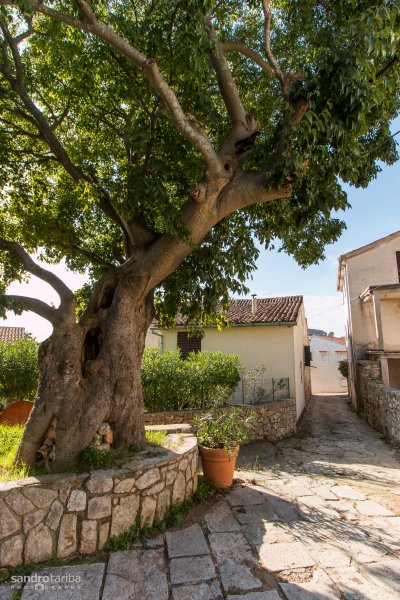| |

 |
|
Many might ask themselves where the name of the village of Ćunski comes from. There are certain assumptions that it might be associated with the Lošinj čunjevi game, meaning a game of boccie, which is quite popular in coastal areas.Many locals still love this game and play it in groups. On Sunday afternoons, you'll often hear them say: „Let's go out for a game of boccie!“Čunjevi or skittles were also used as signs for two-lane sea sailing routes as well as to mark the passages from the villages of Sv. Jakov (St. Jacob) and Nerezine. If you sail off from the west towards the open sea and the island of Male Srakane and then you turn around, you will see that the village of Ćunski stands on the very top of a hill shaped as a skittle or „ćunj“. Polanža lies to its left, Bradičina to its right, while the village of Ćunski stands at its foot.Ćunj – Ćunski.
The present-day village of Ćunski is not an old settlement, although it was inhabited as early as in the pre-historic times. Ever since the Bronze Ages, the fort on the Stan hill and the fort of Polanža had been settled and, during the Roman Empire, Roman country villas were built along the coast. The traces bearing witness to this fact are still found in the Studenčić cove where one can see a potable water well and remnants of a sarcophagus. We do not know precisely at what point during the 16th century the old church of St. Nicolas (Crkva Sv. Nikole) was built, but we do know that it was annexed in 1784 to resemble the Church of St. Mary Magdalene (Crkva Sv. Marije Magladene) in Nerezine. Remnants of this small church were found at the bottom of the newly-erected church at the site of the baptistery with a sacrarium that reached deep into the ground (250 cm) and beneath the foundations of the present-day church leading towards the cemetery. There used to be a small door at that point that were walled in during the restoration of the church. The year 1748 is still impressed on the stone transom of the old rectory, so that it is believed that the priests had lived in it already at that time. The rector's house is considered one of the oldest houses in the village of Ćunski. The church was annexed and rebuilt in 1908, and it was renovated in 2008. The preserved antiquities from the earlier periods include a painted statue of the Virgin Mary with the Christ Child, a statue of St. Nicolas from the 16th century and a painting from the 13th century presenting images of the Virgin Mary, St. Catherine of Siena and St. Dominic. The Stations of the Cross, an oil painting and the paintings of apostles and other saints on the church walls are works by painter Ivan Volarić from Vrbnik created in 1909. The bell tower was built in 1923.
The above information tells us that the church was repeatedly restored and annexed in proportion with the size of the population. The hard-working locals used to cultivate the nearby fertile field. In addition to grains, vegetables and grapes, the surrounding hills were also planted with olive trees,year after year endowing the locals with fruits used to make the precious olive oil.
Apart from agriculture and fishing, tourism has lately started developing as well. Therefore, the presentations and promotional campaigns about the authentic features of the village include the TORAĆ oil factory, a venue representing both the past and the future of the village. Some of the rich heritage is planned to be exhibited and opened for tourist viewing in the renovated Torać. This only preserved olive press mill was built around 1897. At the time olives are harvested, manual method of pressing olives is demonstrated in all its details, as is the sorting of olives in buckets (športe) and collecting the golden-colored oil. During the golden years, two more mills were in use in the Ćunski area, as the need to process olives was substantial. Also, at that time, theArmonia association was formed (present-day Harmonija), which promoted and followed the progress of the village and its citizens.
Betanija – a spiritual retreat center is also situated in Ćunski. It is owned by the Krk Diocese. Since November 2, 1999, when it was consecrated, it has been opened to all those seeking a clearer path towards God and strength for living in faith.
|
|


